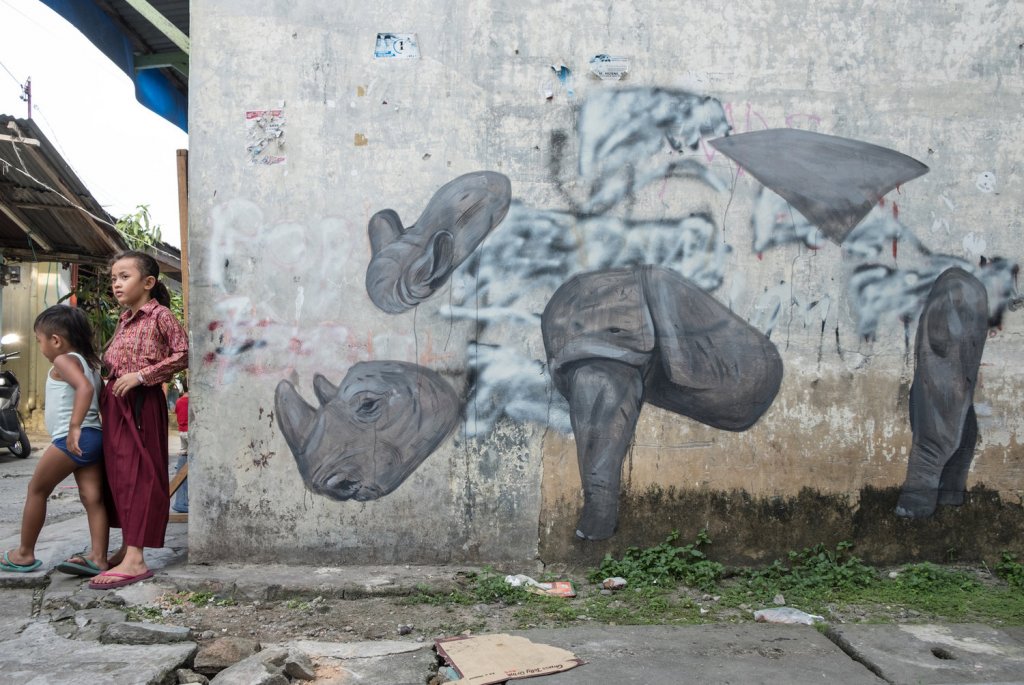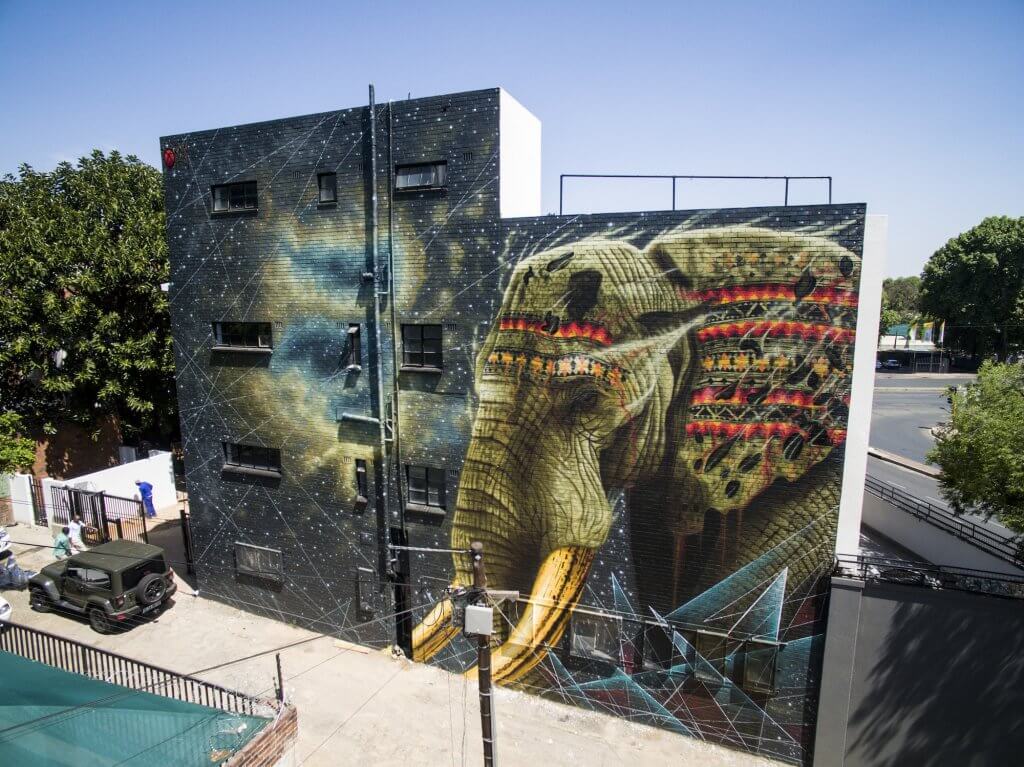The world is home to an incredible variety of animal species, each of which plays an important role in maintaining the balance of our planet’s ecosystems. Unfortunately, many of these animals are endangered, and their populations face threats from various human-led activities. The latest WWF 2022 Living Planet Report shows global wildlife populations have plummeted by 69% on average since 1970.
Street art murals can serve as a powerful tool to raise awareness about these endangered animals and the need to protect them. In this blog, we look at 10 of the world’s most endangered animals, according to WWF, and showcase street art murals highlighting their plight.
1.
Javan Rhinos
Javan rhinos were once widespread in Southeast Asia, but their numbers have drastically declined due to hunting and habitat loss. There are now only around 75 individuals left in the wild, making them one of the rarest rhino species. They can only be found on the island of Java in Indonesia, in the Ujung Kulon National Park, their last remaining refuge. However, the area is threatened by the invading Arenga palm, which reduces the rhinos’ food sources and habitat. The small population is also vulnerable to extinction from natural disasters, disease, poaching and inbreeding. South African-based artist Sonny has been travelling the world with his wildlife protection campaign “‘To The Bone,” which aims to raise funds and awareness for endangered wildlife before it’s too late. His mural of a Rhino brought him to the streets of London. Read more here.

Image Copyright Sonny
2.
Amur Leopards
The Amur leopard is critically endangered, with only around 100 individuals left in the wild. They can only be found in a small region of far-east Russia and northeastern China. Threats to their survival include habitat loss, prey scarcity, and transportation infrastructure such as roads. However, 75% of their range lies in protected areas, and they are moving into suitable habitats outside of these areas, giving hope for their survival. Sonny spent seven days with the ever-changing weather and 240 litres of paint to produce this wild animal in Vladivostok, Russian Far East. Read more here.

Sonny, To the Bone Street Art Mural, Far Eastern Leopard, Vladivostok Russia 2017. Photo Credit Tess Cunliffe.
3.
Sunda Island Tiger
The Sunda Island tiger, also known as the Sumatran tiger, is the smallest subspecies of tiger, weighing up to 140kg. They are rare, with only around 600 left in the wild, and can only be found on the Indonesian island of Sumatra. Due to the increasing human population in southeast Asia, tiger numbers have been shrinking along with their habitats, which has led to a rise in human-tiger conflict. Poaching and illegal trading of tiger parts and products are also major threats to their survival. Artist Hua Tunan plays an active role in protecting the Tigers from the illegal tiger trade. Read more here.

Hua Tunan, 20x21EUG Mural, Street Art Project, Eugene, Oregon 2017. Photo Credit Ben Schorzman
4.
Mountain Gorillas
The Mountain gorilla is a subspecies of the eastern gorilla, living in two isolated populations in high-altitude forests in Congo, Rwanda and Uganda. The Virunga Landscape faces political instability and poverty, which poses a substantial threat to mountain gorilla numbers. Over 500,000 people live near mountain gorilla habitat at present. Despite this, conservation efforts and interventions from local and international partners have helped mountain gorillas make a promising recovery. Currently, just over 1,000 individuals of mountain gorillas are left in the wild, and they remain an endangered species. Animal activist Bordalo II Half Gorilla sculpture addresses plastic pollution and the devastating effects on our animals and nature. The trash sculpture can be found in Coimbra, Portugal, to raise awareness about their endangered status and the need for conservation efforts to protect their habitats. Read more here.

Bordalo II Coimbra, Portugal. Photo copyright Mike Doorline
5.
Tapanuli Orangutan
The Tapanuli orangutan is a critically endangered species of orangutan that was listed as a distinct species in 2017. They are found only in the Batang Toru ecosystem on the island of Sumatra, Indonesia, with a population of fewer than 800 individuals. The loss of habitat due to agriculture, mining, and development has threatened their survival, with over 40% of the forests in their province lost between 1985 and 2007. VHILS (real name Alexander Farto) joined the #Splash and Burn movement to highlight the dangers facing orangutans in Sumatra. He has hand-chiselled a stunning portrait of a Tapanuli orangutan on the streets of Medan. Read more here.

Vhils, Splash & Burn 2018. Photo Credit Ernest Zacharevic
6.
Yangtze Finless Porpoise
The Yangtze Finless Porpoise is the only freshwater porpoise in the world and is critically endangered due to environmental degradation, overfishing and water pollution in the Yangtze River in China. The Yangtze River dolphins used to live alongside finless porpoises but haven’t been sighted for two decades. China has upgraded finless porpoises to the highest level of protection available, and their numbers were around 1,000 in 2018, stabilising in the wild. Festivals such as Pangeaseed Foundation and Sea Walls: Murals for Oceans Street Art Festival are dedicated to the oceans and raising awareness. Read more here.

Kai Kaulukukui and Crackedink, Pangeaseed Foundation, Sea Walls: Murals for Oceans Street Art Festival Churchill, 2017. Photo Credit Tré Packard
7.
Black Rhinos
Between 1960 and 1995, black rhino populations were decimated by poaching, with only 2% surviving. However, since the 1990s, their numbers have doubled across Africa due to conservation efforts. Despite this, black rhinos are still critically endangered, with only 5,630 individuals remaining in the wild. The western black rhino subspecies is now extinct, and 95% of black rhinos are found in just four countries. Poaching remains the biggest threat to their survival, with almost 10,000 African rhinos killed in the last decade for their horns to supply the illegal rhino horn trade. ESCIF painted the disappearing ‘RHINO’ for Splash and Burn, Sumatra 2019. Read more here.

ESCIF, ‘RHINO’ Splash and Burn, Sumatra 2019. Photo Credit Ernest Zacharevic
8.
African Forest Elephants
The African forest elephant is one of two members of the African elephant species. They are critically endangered due to poaching, habitat loss, and human-elephant conflict. Their numbers have declined by an estimated 86% over 31 years, and they now occupy only around 25% of their historic range. The elephants are mainly found in the dense, humid forests of West and Central Africa, scattered among 20 different African nations, with Gabon and the Republic of Congo having the highest populations. Sonny paints a beautiful elephant in Johannesburg. Read more here.

Sonny, Jelani the Elephant, Johannesburg. Photo Credit Sonny
9.
Sumatran Orangutan
The Sumatran orangutan is a critically endangered species found exclusively on the island of Sumatra, Indonesia. Due to threats such as logging, agricultural plantations, and illicit pet trade, its population has declined to less than 14,000 individuals in the wild. Between 1985 and 2007, they lost 60% of their forest habitat, making vast tracts of connecting forests vital for survival. The majority of these orangutans are currently found in the northernmost tip of Sumatra in the Leuser Ecosystem, which comprises tropical lowland rainforests and steamy peatland swamps.

Vhils, Splash & Burn 2018. Photo Credit Ernest Zacharevic
10.
Hawksbill Turtles
The Hawksbill turtle is a marine turtle found in tropical and subtropical waters of the Atlantic, Indian, and Pacific Oceans. Their population is estimated to be between 20,000 and 23,000 nesting turtles, but it is difficult to assess their true population numbers. However, their population has reduced by at least 80% in the last 30 years due to human-led threats such as accidental capture in fishing gears, coral reef damage, and illegal trade of hawksbill shells and products. Hawksbill turtles are currently listed as critically endangered, and other threats like plastic pollution, climate change, and rising sea levels may further contribute to their decline. Street artists around the world have created murals of hawksbill turtles to raise awareness about their endangered status and the need to protect their habitats from human-led activities such as plastic pollution and fishing gear. Festivals such as Pangeaseed Foundation and Sea Walls: Murals for Oceans Street Art Festival are dedicated to the oceans and raising awareness. Read more here.

Midas Sea Walls Murals for Oceans Bali 2018 Pangeaseed. Image Copyright Tre Packard
Street art murals can serve as powerful tools to raise awareness about endangered animal species and the need to protect their habitats from human-led activities; we all need to work towards preserving these animal species and maintaining the balance of our planet’s ecosystems.